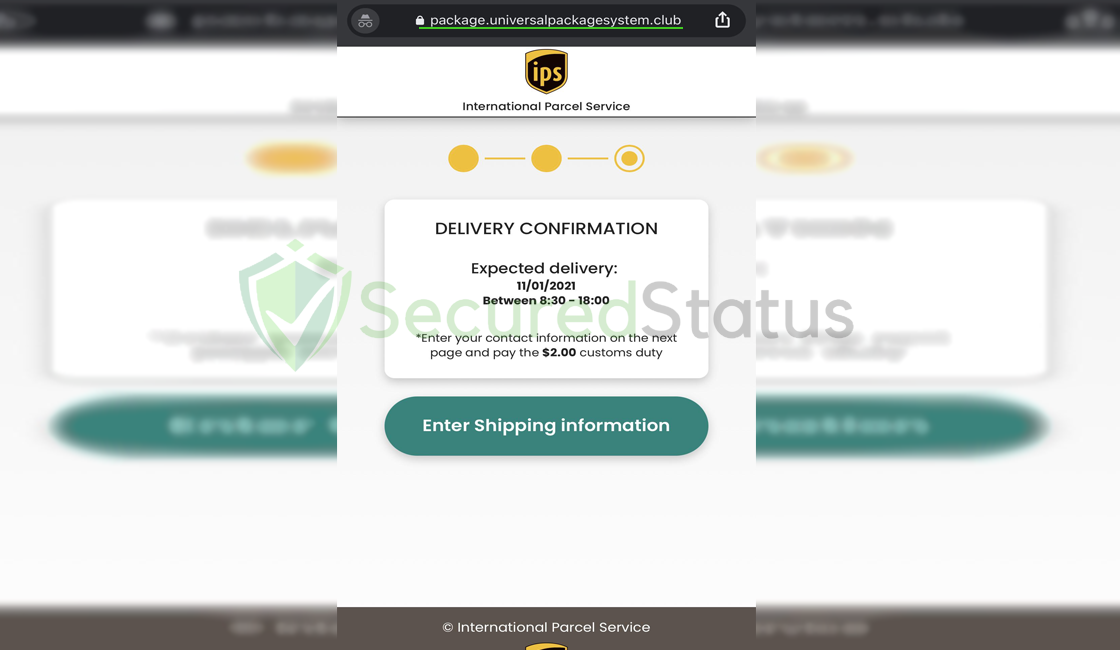The US9514961195221 USPS text scam is another active phishing scam that is identical to this one. It works similarly and has been going around for a while.
Being aware that a large number of consumers have products shipped via IPS and ordered online. Many people are likely to fall for the phony text message.
Phishing is the name for this kind of fraud. It is a form of phishing that uses a text message or phone number. Usually, victims will get a misleading text message that tries to get them to give out their financial or personal information.
To give weight to their claims, these scammers frequently try to pose as a bank, government institution, or other business. In rare cases, the texts may even include your name to give you the impression that they are authentic.
We strongly advise against entertaining any messages you receive from the aforementioned telephone numbers, and even worse, engaging with any links they may contain.
How does the IPS Delivery text scam work?
- These scammers text users regarding the delivery of their packages while posing as the IPS tracking number.
- The message’s primary focus will be on addressing delivery issues such as an inaccurate address being provided.
- Following that, they will request an adjustment charge and send a link to confirm the information.
- You will be tricked to enter your credit/debit card details into the text fields and they will have access to it.
Their main goal is not to collect the $3 fee but to obtain your financial information so they can withdraw and use the funds from your bank account.
Many people have reported receiving the texts listed below, while individual users may have received different texts. The following are the most typical messages:
Message 1:
#DELlVERY ALERT (!): consignment #CS78943819283ZA is ready for pick-up in:
XXXXX Town. XXXXXX, check where to pick it up here: afaxaj.com/lWcZHGm
Message 2:
Shipment attempt 2/2 - John Doe, ltem-lPS208497103ZA needs your attention,
and will be returned, if not confirmed: igadez.com/qpKzERN
Message 3:
Your order P0135920134-ZA was to be delivered on 02/12/2022 to your drop-off-point.
Collect it here: ufekij.com/qdTfKXE
Message 4:
Shipment attempt 2/2 - (Cellphone number), your ltem-lPS208497103ZA,
will be returned 17-11-2022, if not confirmed: ohodiv.com/AxQixff
Since the fake IPS SMS campaign has not yet seen a fall, there are many more variations of these texts and there will be more in the future.
However, you should exercise caution and pay attention to any messages from unknown senders that contain a dubious link.
The bogus link’s content, which is on a phishing website, resembles the following:

Please be aware that the website displayed is not the actual IPS tracking form, but rather a website created to look like one. The layout itself is consistent with the original website. However, if we examine the site’s link, it is clear that it is fake.
Does IPS send text messages about deliveries?
Unless you have a delivery scheduled soon or if you asked them to SMS you the package’s status. Apart from that, IPS does not need to inform you about specific delivery.
You can choose to receive email or SMS notifications before a delivery is made by IPS. You shouldn’t be receiving SMS messages if you selected the latter.
Not to mention, they communicate in a formal, professional manner as opposed to scammers, who use haste to make their victims worry and click the link.
What should I do after receiving the fake IPS text message?
The first thing you should do is to relax since nothing that you have ordered for delivery will have difficulty getting to your house, and if you don’t have anything to pick up, nothing will be showing up at your door.
Report the sender’s phone number to the cybercrime enforcement agencies in your nation so that the number can eventually be blocked and the offender can be located by investigation.
For United States Citizens: You may email spam@uspis.gov or mail the Federal Trade Commission (FTC) at their official website.
For United Kingdom Citizens: You may visit Actionfraud.police.uk and file a report or call their number via 0300 123 2040.
For France Citizens: You may file your report via the Service-Public.fr website.
For Australian Citizens: You can use ReportCyber to file a report or call the Australian Cyber Security Hotline at 1300 292 371.
For Canadian Citizens: Contact the Canadian Anti-Fraud Centre or call their number 1-888-495-8501.
After that, you should block the sender’s number to ensure that you don’t continue to receive texts from them. Any further interactions with the scammer may get your number spoofed or even worse.
What should I do if I clicked the link?
When you click the link, you will be taken to a phishing website that imitates the IPS website, as we previously mentioned. You are generally secure if you merely clicked the link and did not do anything further on the website.
However, further action should be done if you had provided the information requested by the text field boxes, such as your home address and credit card information.
The most concerning aspect is the financial information you have shared because they won’t do anything with your home location.
To prevent losing money to scammers using your bank balance, get in touch with your bank right away. Request that they look into the matter and restrict any further transactions. For additional security, you should set up two-factor authentication and change the passwords on every one of your accounts.
Final Thoughts
Even after taking the necessary precautions to secure your accounts, it can be very unsettling to have received a bogus text message and shared your financial information with scammers.
This is why we advise that two-factor authentication be enabled on all accounts, making every activity subject to the requirement of a specific pin code that can only be provided to your mobile device.
